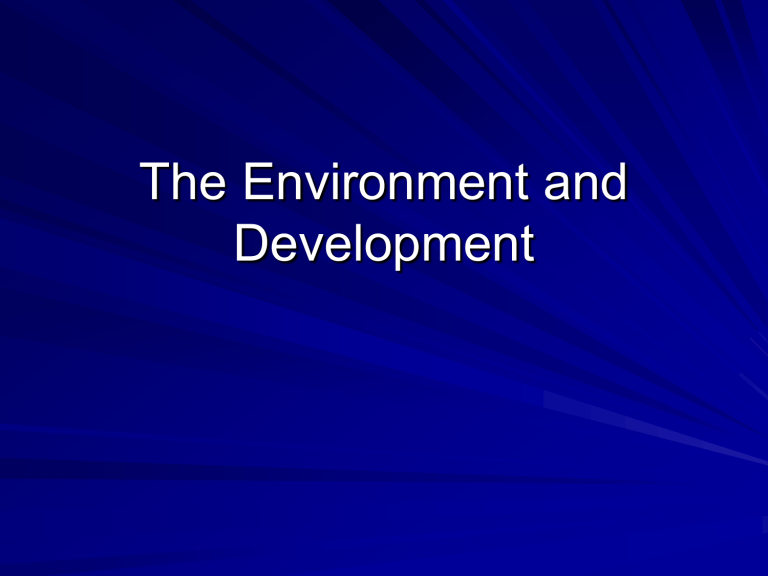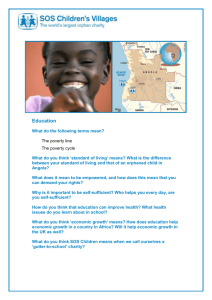The Environment and Development

The Environment and
Development
The Environment and Development: Outline
Basic Issues regarding environment and development
Economic Models of the environment
Rural development and environment
Poverty and environment
Urban development and environment
Policy options in developing and developed countries: Case Study on debt swaps
The Environment and Development: Basic
Issues
Sustainable development and environmental accounting
Population, resources, and the environment
Poverty and the environment
Growth versus the environment
Rural development and the environment
Urban development and the environment
The global environment
Economic Models of the Environment
Traditional model advocates that so long as all resources are privately owned and there are no market distortions, resources will be efficiently allocated. Therefore, there will be misallocation in a CPR market.
– Properties of a perfect property rights market and does it exist in developing countries?
– What about issues of equity
Model for regional environmental degradation and the free-rider problem
– Any limitations to the above model??
Poverty and Environment
Poverty is viewed as encompassing both income and non-income dimensions of deprivation , lack of empowerment , and extreme vulnerability to external shocks
Environment refers to the living and non-living components of the natural world, and to the interactions between them, that support life on earth. The environment is a provider of goods and services and is also a recipient of waste products
Poverty and Environment: Concerns
Poverty and environment linkages are dynamic and context-specific
Rural poor are concerned with secure access to and the quality of natural resources
Urban poor are concerned with access to clean water, energy, sanitation, and security of housing
Poor women are concerned with safe and close access to potable water and energy supplies
Rural Poverty/ Development and
Environment
Rural poverty and environmental degradation interact leading to
Soil erosion and
Desertification
Deforestation and loss of livelihood
Fuel shortages, lower agricultural productivity, occurrence of natural disasters
Loss of ground water
Urban Poverty/ Development and
Environment
Urban poverty causes environmental degradation in two ways:
– Industrialization and urban air pollution
Environmental Kuznets curve
Role of taxation in controlling pollution externalities
– Congestion and availability of clean water and sanitation
Productivity losses
Financial feasibility of providing clean drinking water and sanitation for all
Poverty and Environment: Linkages
Poor people are the main victims of a bad environment
– Poor people are more vulnerable to the loss of biological resources
– Extreme environmental stress can force the poor to migrate
– Inequality reinforces environmental pressure
– Government policies can create or reinforce vicious cycle of poverty-environment interaction
Poor people are agents of environmental degradation (poverty and exploitation)
– Poor people have shorter time horizons, which exacerbates environmental degradation
– Poverty increases risk-aversion and discount rates, aggravating environmental pressure
Poverty and Environment : Linkages
Incomplete property rights reinforce the vicious poverty-environment circle
Population pressure exacerbates both poverty and environmental degradation
Links between the Environment and Millennium
Development Goals
Goal Links to environment
Eradicate extreme poverty and hunger
Achieve universal primary education
Reduce child mortality
Improve maternal health
Combat major diseases
Ensure environ sustainability
Livelihood strategies & food security depend on healthy environment
Time spent colleting fuel and water by children
Water-related diseases kill 3 M people in developing countries
Indoor air pollution and carrying heavy loads
1/5 th of the total burden of disease in developing countries may be associated with environmental risk factors
Environ degradation must be reversed
Policy opportunities to reduce poverty and improve environment
Improve governance
– Integrate poverty-environment issues into national development frameworks
– Strengthen decentralization
– Empower poor and marginalized groups
– Address gender dimensions
– Strengthen anti-corruption measures
– Reduce environment-related conflict
– Improve poverty-environment monitoring and assessment
Policy opportunities to reduce poverty and improve environment
Enhance the assets of the poor
– Strengthen resource rights of the poor
– Enhance poor’s capacity to manage environment
– Expand access to environmentally-sound and locally appropriate technology
– Reduce environmental vulnerability of the poor
Policy opportunities to reduce poverty and improve environment
Improve the quality of growth
– Integrate poverty-environment issues into economic policy reforms
– Increase the use of environmental valuation
– Encourage private sector involvement in environmental management
– Implement pro-poor environmental fiscal reform
Policy opportunities to reduce poverty and improve environment
Reform domestic international and industrial policies
– Industrial emissions abatement policies
– Reform trade policies
– Make FDI more pro-poor
– Enhance the contribution of multilateral environmental agreements to poverty reduction
– Encourage sustainable consumption and production
– Enhance the effectiveness of development cooperation and debt relief
Case studies used:
– Environment and Development: Causes of
Deforestation in the Brazilian Amazon Rain Forest and the Policy Response
– How Has a Debt-for-Nature Swap Worked in Practice?
The Case of Bolivia
Both are available at http://wps.aw.com/wps/media/objects/277/284582/t odarocasestudies.pdf






